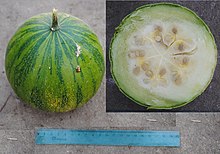Cucurbita ecuadorensis
| Cucurbita ecuadorensis | |
|---|---|

| |
| Mature fruit and cut showing pulp and seeds. | |
| Scientific classification | |
| Kingdom: | Plantae |
| Clade: | Tracheophytes |
| Clade: | Angiosperms |
| Clade: | Eudicots |
| Clade: | Rosids |
| Order: | Cucurbitales |
| Family: | Cucurbitaceae |
| Genus: | Cucurbita |
| Species: | C. ecuadorensis
|
| Binomial name | |
| Cucurbita ecuadorensis | |
Cucurbita ecuadorensis is a species of squash, discovered in 1965 growing wild in Ecuador.[3] Like most wild gourds and squashes, it is creeping vine and is often found climbing over other vegetation.[1] It has been found only in the western provinces of Guayas and Manabi.[4] There is evidence that it was domesticated in Ecuador around 10,000 years ago, likely for its seeds, but no direct records exist and it is no longer cultivated.[5] It is resistant to many diseases of cultivated Cucurbita species,[6] and has been used to breed resistance to several diseases into common squashes.[7] For example, researchers at Cornell University used Cucurbita ecuadorensis to breed resistance to papaya ringspot virus, watermelon mosaic virus, and powdery mildew, into common Cucurbita maxima cultivars.[7] Cucurbita ecuadorensis is listed on the IUCN Red List as vulnerable,[1] and is found protected in the Machalilla National Park.[1]
References[]
- ^ a b c d "Cucurbita ecuadorensis". IUCN Red List of Threatened Species. Retrieved 14 May 2013.
- ^ Cutler, Hugh C.; Whitaker, Thomas W. (1968). "A New Species of Cucurbita From Ecuador". Annals of the Missouri Botanical Garden. 55 (3): 392–396. doi:10.2307/2395132. JSTOR 2395132.
- ^ Cutler, Hugh C.; Whitaker, Thomas W. (1968). "A New Species of Cucurbita from Ecuador". Annals of the Missouri Botanical Garden. Missouri Botanical Garden Press. 55 (3): 392. doi:10.2307/2395132. JSTOR 2395132.
- ^ "Cucurbita ecuadorensis". Germplasm Resources Information Network (GRIN). Agricultural Research Service (ARS), United States Department of Agriculture (USDA). Retrieved 21 December 2017.
- ^ Hancock, James (2012). Plant evolution and the origin of crop species. Oxfordshire: CAB International. p. 237. ISBN 9780851998749.
- ^ R. Dumas de Vaulx and M. Pitrat. "Realization of the Interspecific Hybridization (F1 and BC1) Between Cucurbita pepo and C. ecuadorensis". North Carolina State University. Retrieved 14 May 2013.[permanent dead link]
- ^ a b Cole, Chittaranjan (2012). Genetics Genomics and Breeding of Cucurbits. Clemson, South Carolina, USA: Science Publishers. p. 40. ISBN 9781578087662.
External links[]
- IUCN Red List vulnerable species
- Squashes and pumpkins
- Endemic flora of Ecuador
- Cucurbita
- Plants described in 1969
- Cucurbitales stubs

